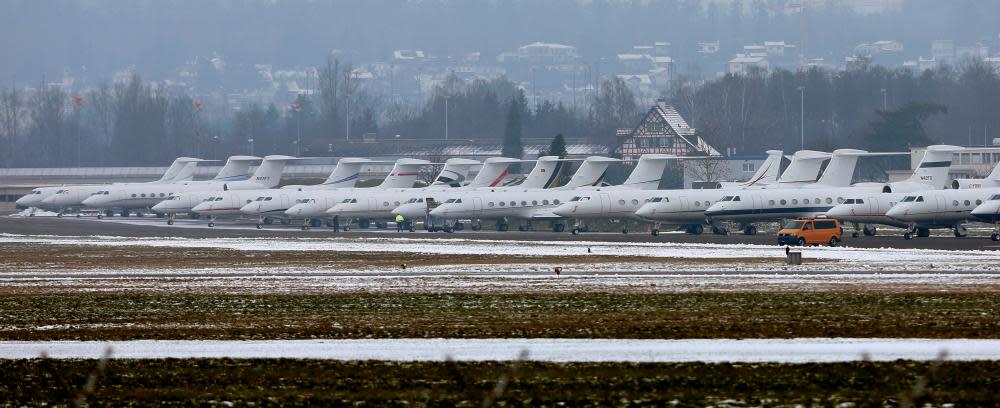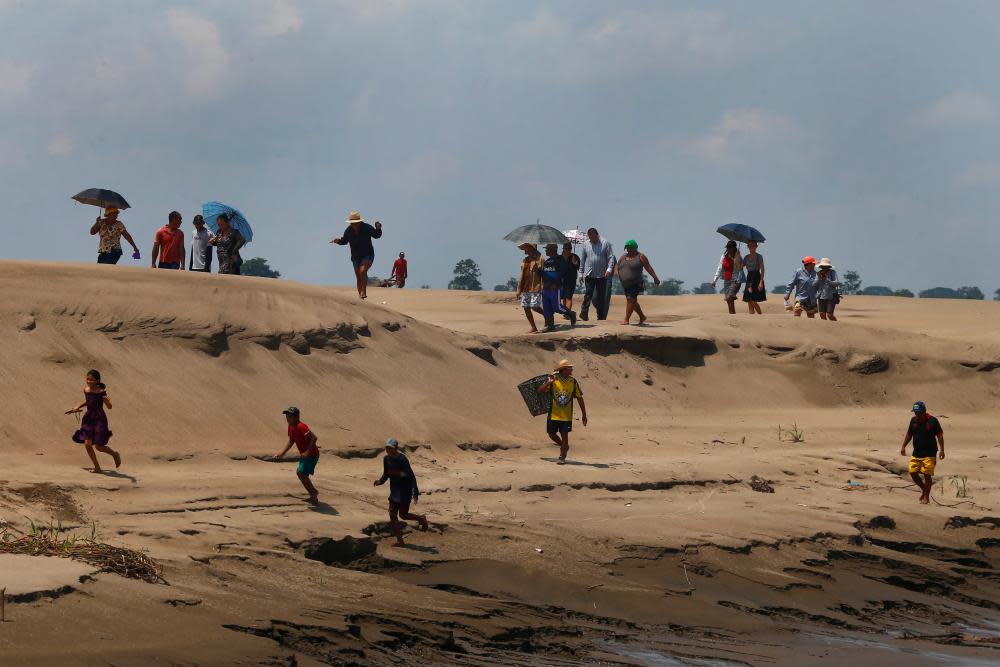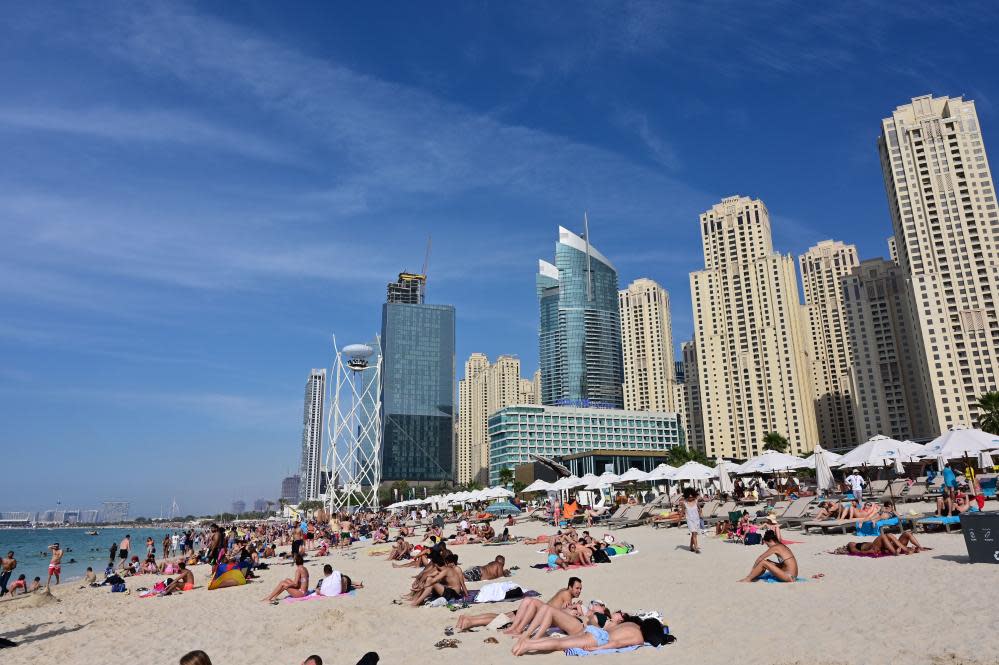The great carbon divide
default
default
The climate chasm between the world’s carbon-guzzling rich and the heat-vulnerable poor forms a symbolic shape when plotted on a graph. Climate-heating greenhouse gas emissions are so heavily concentrated among a rich minority that the image resembles one of those old-fashioned broad-bowled, saucer-shaped glasses beloved of the gilded age: a champagne coupe.
At the top is the wide, flat, very shallow bowl of the richest 10% of humanity, whose carbon appetite – through personal consumption, investment portfolios, and share of government subsidies and infrastructure benefits – accounts for about 50% of all emissions.
Just below is the epicure, that narrowing joint of the glass where the dregs collect. This is made up of the middle 40%, whose carbon habit is roughly proportionate to its number but still double the average carbon budget that everyone would need to stick to if the world is to have any chance of avoiding more dangerous levels of climate breakdown.
Going further down is the long, slim, fragile stem comprising the remaining 50% of the world’s population, whose carbon use tapers away along with incomes. At the bottom are the hundreds of millions who live in extreme poverty and barely register in terms of greenhouse gases.
The champagne coupe is a fitting image for the great carbon divide that we are living through. The last time wealth inequality was as pronounced as it is now was during that belle époque of the 1920s. Then, it was bad enough as a cause of social misery and international instability. Today, it is arguably much worse because the gulf between the haves and have-nots extends to their carbon emissions, which heightens suffering from the climate crisis and impedes efforts to find a solution.
This year, the extremes have been more apparent than ever. Oil firms have raked in trillions of dollars in profits that they plan to use to expand production of climate-destabilising fossil fuels despite warnings from the International Energy Agency that this will make it impossible to keep global heating to within 1.5C.
Meanwhile, 2023 is on track to be the hottest year on record, and the victims of global heating and extreme weather have been legion. From the dozens of poor Central American migrants who died from heatstroke trying to cross the desert into the wealthy US, to the 18 north Africans, including two children, who burned to death as they attempted to pass through Greek forests engulfed by flames; from the thousands of Hebei villagers who lost their homes when the Chinese government diverted flood waters from wealthy Beijing, to the Mexican fishing community of El Bosque that is being eroded due to more frequent storms battering its coastline. Speaking from an emergency refuge, Guadalupe Cobos Pacheco, a resident of El Bosque, said she felt resentment towards the oil companies that operated platforms within sight of her disappearing village. “We are living in a total climate breakdown. It is a constant worry … we don’t know what to do,” she said. “All this oil exploitation has consequences yet it is we who are paying.”
These are just a few of the many individual stories of climate breakdown. Together, they have the potential to fundamentally destabilise life for all of us. Climate justice is expected to be high on the agenda of the UN Cop28 climate summit in Dubai starting later this month. In principle, rich nations have agreed on a “loss and damage fund” to help poor countries cope with the ever more severe fallout from the crisis. But this is not the only form of inequality. Income gaps – and therefore carbon gaps – may have narrowed between countries but they have widened within them. Responsibility for the ongoing climate crisis is becoming more concentrated, while its impacts are spreading.
Why is carbon inequality widening? What drives the lifestyle and investment choices of the rich? How is carbon inequality linked with other systemic injustices? And what can be done about it? This week, the Guardian will attempt to answer these questions with a special investigation into the great carbon divide. For the past six months, our team of specialist environment and climate justice reporters have had an exclusive inside track on research that quantifies global carbon inequality, carried out by Oxfam, the Stockholm Environment Institute and other experts. Today, we reveal the main finding of Oxfam’s report: that the richest 1% of the population produced as much carbon pollution in one year as the 5 billion people who make up the poorest two-thirds.

This is not just another exercise in comparing individual carbon usage – the cunning ruse that was promoted by the oil firm BP almost 20 years ago. Concerned about the damage being done to its corporate reputation by the climate crisis, BP hired a public relations firm to bolster its image. One of the most effective strategies that emerged was the launch in 2004 of a carbon footprint calculator, which encouraged consumers to bear responsibility for their greenhouse gas emissions, instead of the producers who were making trillions from pumping oil and gas out of the ground, advertising to boost sales, and lobbying to delay emissions reductions. This also became the basis for the dubious accounting trick of carbon offsets, which has been an excuse for big polluters to continue polluting. To avoid this trap, the climate movement has understandably tended to downplay individual footprints and to focus instead on the importance of political and economic reforms.
The Guardian has previously shone a spotlight on the top 20 fossil fuel firms behind a third of all emissions. We have also analysed the total emissions of countries since 1850 to reveal the nations with the greatest historical responsibility for the climate emergency. But as we show in this new series, inequality between people has increasingly become a structural impediment to climate justice and climate action. We humans are not equally to blame for rising temperatures, more destructive storms, longer droughts and fiercer forest fires. Recognising that is an important step in identifying the cause of the problem, possible solutions and fair compensation for those affected.

Closer scrutiny of billionaires is an essential first step. This economic elite has grown richer faster than any other demographic in recent decades and, though they number just 2,600, their combined wealth is greater than all but two countries – the US and China – and their climate impact is enormous.
Lower down the income scale, the inequalities are still jarring. The top 10%, who are paid at least US$40,000 (£32,000) – which probably includes many Guardian readers – are responsible for 50% of emissions. They may feel less culpable than the super-rich but there are many more of them, so their combined impact is considerable.
“We are not equally to blame for these emissions, nor for the damage they cause,” the climate activist Greta Thunberg writes in the preface to Oxfam’s report. “Either we safeguard living conditions for all future generations or we let a few very rich people maintain their destructive lifestyles and preserve an economic system geared towards short-term economic growth and shareholder profit.”
Emily Ghosh, of the Stockholm Environment Institute, said the new climate inequality data showed the need for a different approach. “With the climate problem, we can’t ignore what people in the top 1% and 10% are doing. They have a global impact,” she said. “We need to address this because it has gone unchallenged for too long. We need to look more closely to see how investments lock us into certain patterns of consumption, and who makes those decisions. There needs to be a strong shift in power.”

Unequal UAE
Delegates at Cop28 need only step out of the security gates of the conference centre in Dubai to witness the carbon divide. The United Arab Emirates is one of the world’s most unequal nations, largely as a result of the wealth that its rulers have accumulated from pumping oil and gas out of the desert, and the poor conditions of the migrant workers who make up 80% of the population.
Its ruler, Sheikh Mohamed bin Zayed Al Nahyan, is the scion of arguably the richest family on the planet. By one estimate, the Al Nahyan clan, who own 6% of the world’s oil reserves, are worth more than $300bn. The family’s climate footprint from investments is similarly spectacular. The Al Nahyan royals control International Holding Co, which owns stakes in, among other things, Manchester City football club, a Formula One racetrack, the Ferrari World indoor theme park, the spacecraft manufacturer SpaceX, large chunks of London’s Berkeley Square and a dozen or so palaces. This month, it raised its stake in the Indian coalmining company Adani Enterprises. It recently had the fastest-growing stock valuation in the world – 28,000% in just five years.
At the other end of the spectrum is the climate-vulnerable migrant labour force, mostly from India, the Philippines and north Africa. They work on construction sites, in restaurants and as office cleaners, with monthly incomes ranging from $300 to $750, barely enough to cover rent. Their carbon consumption is marginal and their climate exposure is dangerously high. Many labour outside where temperatures frequently exceed 40C, including as part of the Cop28 preparations, and they make up a disproportionate number of heatstroke cases. If global temperatures rise to 3C above pre-industrial levels, which is where the world is heading, then the number of extremely hot days each year in Dubai will double.
It is a similar story in many parts of the world, where temperature has become a marker of social status. In Mumbai, India, the vast Dharavi slum gets more than 5C hotter than the neighbouring gated communities of the middle class. In São Paulo, Brazil, tens of thousands of residents crammed into the poorly ventilated and drought-afflicted Paraisópolis (Paradise City) favela look up at their wealthy middle-class neighbours in a residential tower where each of the 12 floors has a balcony with a swimming pool.
It is becoming clearer that the climate crisis worsens inequality and inequality worsens the climate crisis. According to a formula used by the US Environmental Protection Agency, there are 226 excess deaths worldwide for every million tonnes of carbon pumped into the air. Based on this “mortality cost” formula, Oxfam calculates that the emissions of the richest 1% in one year are enough to cause 1.3m deaths over the coming decades from excess heat and other climate impacts. Or take food supplies: Oxfam estimates that the combined effect of the carbon emissions of the 1% over the past 30 years are equivalent to wiping out an entire year’s harvest of EU corn, US wheat, Bangladeshi rice and Chinese soya beans.
And it is not just poor countries that are affected. Carbon inequality and climate injustice are intertwined with sexism, racism, the denial of indigenous rights and other drivers of inequality. Studies have shown that black residents in New York are twice as likely to die of heat-related diseases as white residents. Black neighbourhoods in New Orleans and Houston bore the greatest losses from Hurricane Katrina and Hurricane Harvey.
‘Polluter elite’
Climate anxiety means different things to different income groups. At the bottom, it means fear of heat and floods. At the top, it means fear of increasingly desperate people. Billionaires often live in protective bubbles maintained at a considerable cost in dollars and emissions. Some are preparing for “the event”, with plans for doomsday bunkers in New Zealand, Nevada and other remote areas. Others blast off the planet in private rockets and talk of colonising space. Instead of making every effort to reduce emissions, the rich increase their carbon footprint by putting more distance between themselves and the masses.
The Oxfam report reveals that the decision-making classes who will dominate at Cop28 – senior politicians including US senators, British ministers and European commissioners – are also in the top 1% of income earners. Corporate CEOs, whose lobbyists also flock to Cop summits, are often wealthier and more heavily invested in carbon assets. Boardroom share options and bonus structures have created an incentive for oil company executives to resist climate action. Instead, they have successfully pushed for expansion of fossil fuel production. Dario Kenner, the author of Carbon Inequality, has identified what he calls a “polluter elite”: anyone with a net worth over $1m who reinforces the use of fossil fuel technologies through their high carbon consumption, investments in polluting companies and, most importantly, political influence. “The polluter elite have blocked an alternative history where the destruction of extreme weather events and air pollution could have been reduced,” he told the Guardian.
The international climate negotiating process has failed to keep pace with the growing power of the super-rich. Thirty-one years ago, when the world first came together to tackle climate and biodiversity problems at the Rio de Janeiro Earth summit, there was optimism for a solution on behalf of billions of humans and the countless other forms of life on Earth. Since then, the opposite has happened. Governments remain deeply divided, 60% more emissions are being pumped into the atmosphere and more money, carbon and power is being concentrated in ever fewer hands.
The solution to all this is complex but also very simple. Many believe that the key lies in politicians wresting back control of the climate issue with strong legislation and policy. Oxfam is calling for a wealth tax, and a windfall tax on corporations based on the “polluter pays” principle, placing the highest burden on those most responsible and most able to pay.
“We need a political discourse that is class conscious, that recognises that the rich and capitalism are the major drivers of the climate crisis,” said Jason Hickel, an economic anthropologist at the London School of Economics and the author of The Divide: A Brief Guide to Global Inequality and its Solutions. “This is about bringing production – and provisioning systems and energy systems – under democratic control.”
With the climate crisis entering a deadlier phase, and millions of lives and livelihoods at stake, such arguments are likely to grow louder. Scientists have demonstrated that every fraction of a degree is worth fighting for. Equality campaigners argue that every percentile of income gap that can be reduced is worth fighting for. Both will decide how many fall into the rapidly widening climate gulf.
• Additional reporting by Damien Gayle and Fiona Harvey
• Ngân Bùi is an illustrator living and working in Vietnam


